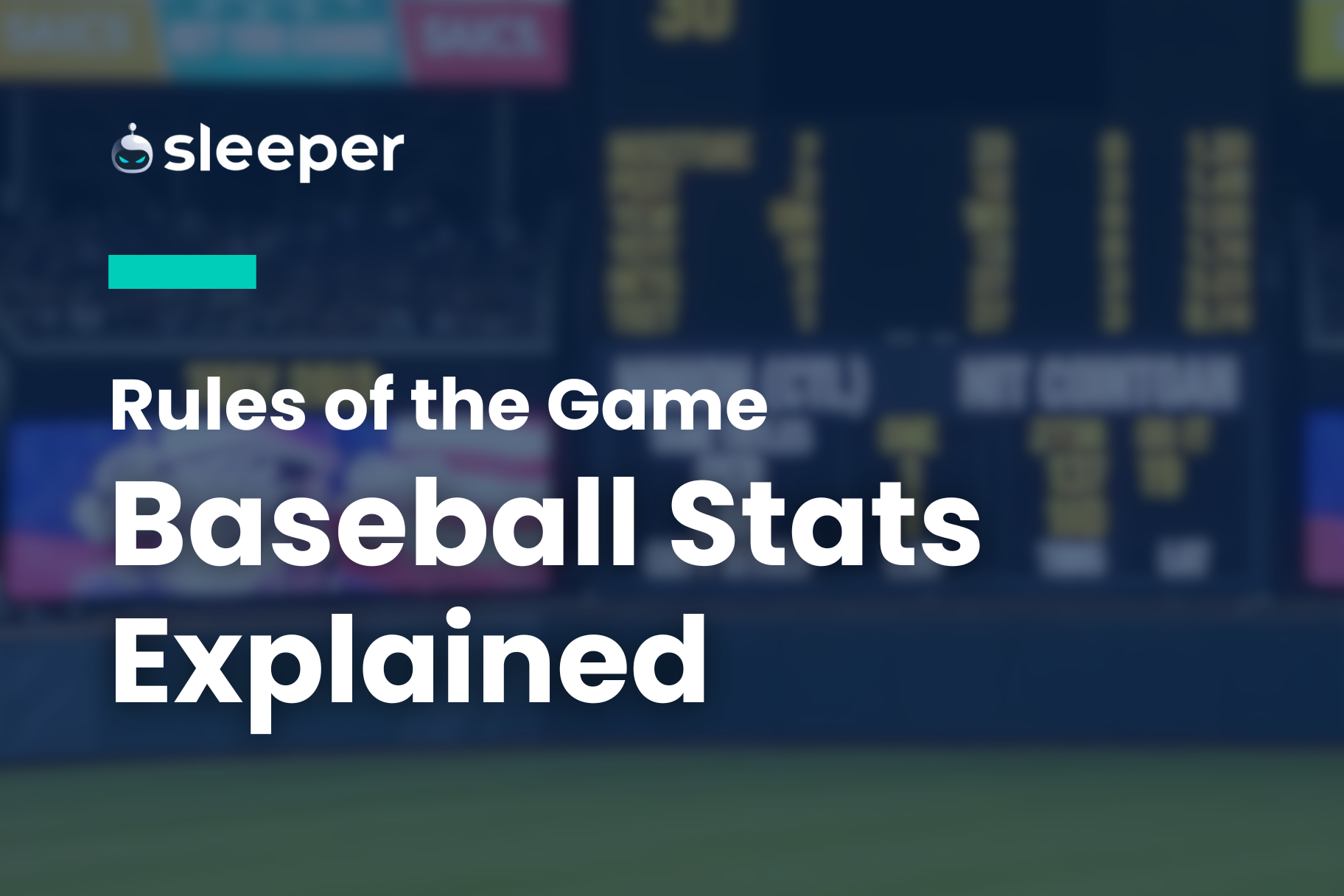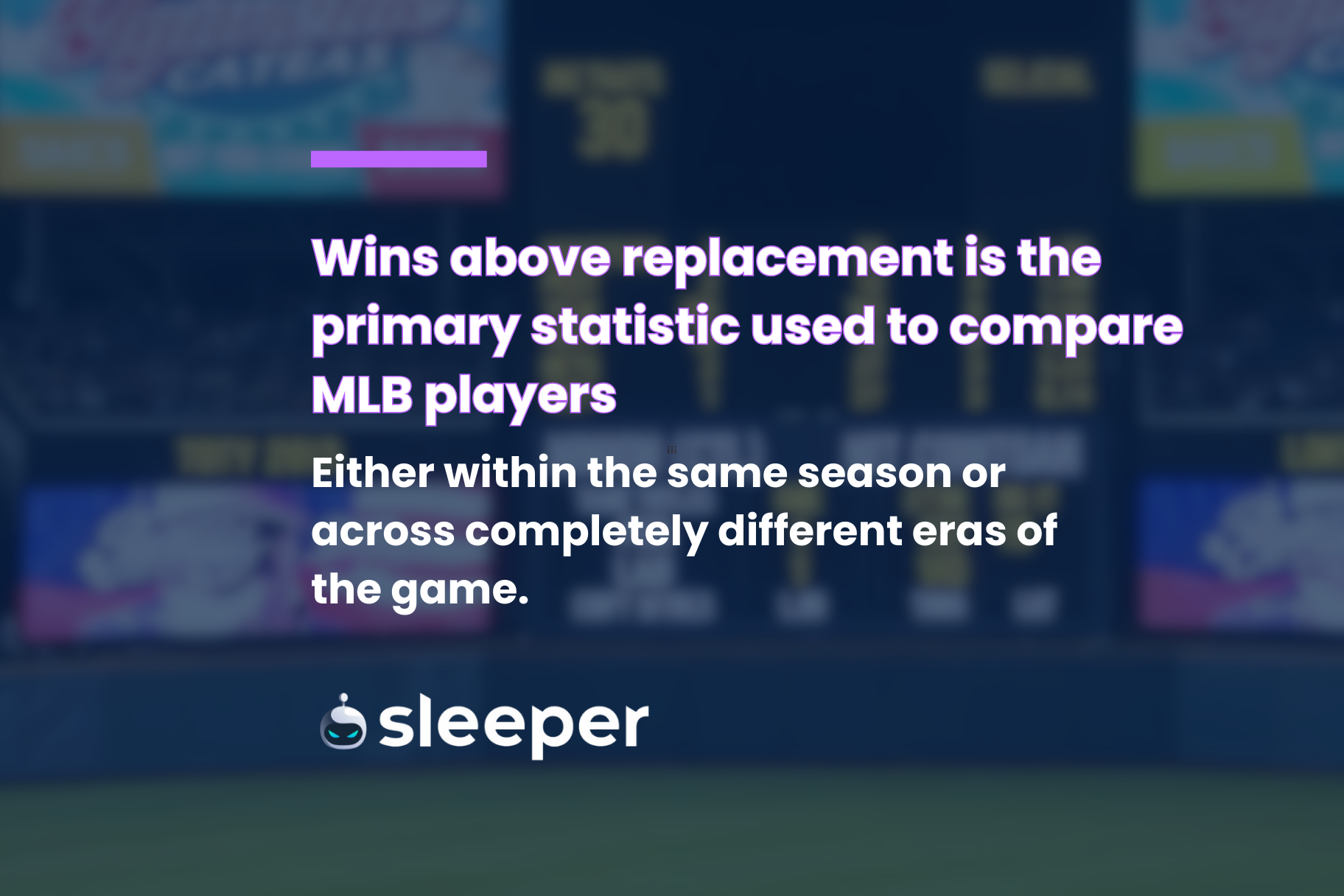From RBI to ERA, WAR and OPS, baseball is loaded with abbreviations that we’ll help you understand.

Baseball 101: Baseball Stats Abbreviations Explained
These days, every professional sport has tons of advanced statistics and full-blown analytics departments for each franchise.
But no sport quite loves its stats like baseball does.
With more acronyms than an AOL chat room in the early 2000s, the sheer volume of baseball statistics can make it equal parts intimidating and confusing to dive headlong into America’s national pastime.
Give us just a few minutes of your time, though, and we’ll fill you in on all the essential baseball stats to know.
How to Read Baseball Stats: Basic Batting Stats Explained
Plate Appearances (PA) and At Bats (AB)
The former is quite simply the number of times a batter comes up to the plate, no matter the result. The latter is plate appearances minus any walks, sacrifice bunts/flies or hit by pitch.
Like the relationship between squares and rectangles, all AB are PA, but not all PA are AB. (Typically around 90 percent of PA are AB.)
Hits (H), Walks (BB) and Hit by Pitch (HBP)
A hit is when the batter puts the ball in play and safely reaches base without either an out or an error occurring. Hits can be singles, doubles, triples or home runs.
A walk (or base on balls, hence the BB abbreviation) is when a batter draws four balls and is awarded first base. Batters can also be awarded first base by getting hit by a pitch. An HBP might be quicker than drawing a BB, but it’s definitely more painful.
Sacrifice Hits/Bunts (SH) and Sacrifice Flies (SF)
The first is when a batter bunts the ball with the intention of advancing the runner(s) already on base. The second is a fly out that is hit deep enough for a runner on third base to tag up and score.
Both are called sacrifices, because the batter is basically giving up its AB for the betterment of the team. Neither is exactly a major stat that baseball fans follow, but they’re worth mentioning here because they factor into PA/AB and several of the other batting stats we’re about to address.
Runs (R), Home Runs (HR) and Runs Batted In (RBI)
Soccer and hockey have goals. Football and basketball have points. Baseball has runs. The winning team is the one that scores the most.
Runs are scored by making it all the way around the diamond—from home to first base to second base to third base and back to home—without getting out (They can also be scored by pinch-runners, who enter in place of a batter who got on base).
A home run is when that entire revolution of the bases occurs in the same plate appearance (without any errors). The vast majority of HR are hit over the fence in the outfield, resulting in a leisurely stroll around the bases. Every once in a while, though, a player will hit an inside-the-park HR.
RBI is for the most part the number of runs that score as a result of a plate appearance. If a run scores because of a wild pitch/passed ball or an error, or if the batter hits into a double play that produces a run, the batter is not credited with an RBI. For about 95-96% of all runs scored, though, there is an RBI for the hitter.
Batting Average (BA or AVG), On-Base Percentage (OBP) and Slugging Percentage (SLG)
Why did we care about the difference between PA and AB?
For calculating AVG and OBP, of course!
AVG is simply hits divided by AB. In Major League Baseball, the sport-wide batting average has been hovering in the .240 to .250 range for a few years. Anything above .300 is impressive, while anything below .200 (sometimes called the “Mendoza Line” in reference to Mario Mendoza, a shortstop in the 1970s and 80s) is rather poor.
OBP is a bit more complicated, with [H + BB + HBP] on top of the fraction and [PA - sacrifice bunts] on the bottom of the fraction. MLB-wide OBP is usually around .315, with many All-Star caliber players able to finish the season north of .400.
SLG is basically AVG with an extra-bases multiplier. Instead of just hits divided by AB, SLG is total bases divided by AB, where a single is one total base, a double is two total bases, a triple is three total bases and a home run is four total bases. MLB-wide slugging is usually around .400, but there are often a couple of power hitters each season who end up at .600 or better.
Collectively, AVG, OBP and SLG are presented (in that order) in what is called a batter’s “triple slash.” Babe Ruth’s career triple slash was .342/.474/.690.
On Base Percentage plus Slugging Percentage or On-Base Plus Slugging (OPS)
The peanut butter and jelly of batting statistics, OBP and SLG are infinitely more popular when combined than each is individually. That’s because it’s the best of both worlds, combining a hitter’s ability to reach base and hit for extra bases.
And while you might recall that a .400 OBP is great and that a .600 SLG is super swell, there’s just something aesthetically pleasing and easy to remember about a 1.000 OPS being a benchmark for all-time greatness.
Stolen Bases (SB)
This is when a baserunner takes an extra base in the middle of a plate appearance; however, it does not include cases where that additional base is taken as a result of a wild pitch (WP) or passed ball (PB).
This also does not include bases taken due to defensive indifference (DI), which will often happen in the ninth inning if that runner doesn’t really matter. (For instance, if the team that is batting is trailing by a solid margin and there’s a runner on first base, the defense sometimes won’t even bother trying to prevent that runner from taking second base, instead prioritizing being in the best possible positions to retire the batter.)
See also: Baseball Rules for Beginners
How to Read Baseball Stats: Basic Pitching Stats Explained
Strikeouts (K)
Three strikes and you’re out.
This is both a hitting and pitching statistic, but is predominantly discussed on the pitching side of the equation. An exception to that rule is if we’re talking about a “golden sombrero” when a batter strikes out four times in a single game, or the rare “platinum sombrero” for five whiffs in a game.
Why is the abbreviation a K, though?
Legend has it it’s because when Henry Chadwick developed baseball’s first scorecard in 1859, he had already used “S” for sacrifice and needed something different for a strikeout. The terminology back then was that a batter “struck three times,” and the “K” from struck is what ultimately stuck.
Innings Pitched (IP)
It’s very obviously the number of innings a pitcher racks up, which is determined by the number of outs a pitcher has recorded.
One out is called and calculated as one-third of an inning, but it is expressed as .1 IP as opposed to .333 IP. So if a starting pitcher makes it through five innings and gets two outs in the sixth inning before being replaced by a relief pitcher, that pitcher is credited with 5.2 IP.
Earned Run Average (ERA)
The number of earned runs allowed (runs scored minus those that scored because of errors) divided by innings pitched, multiplied by nine.
In that same 5.2 IP example above, if the pitcher allowed two earned runs, it had a 3.18 ERA for the day.
Over the course of a full season, the MLB-wide ERA typically lands in the 3.90 to 4.50 range.
Walks plus Hits per Inning Pitched (WHIP)
A basic measurement of baserunners allowed by a pitcher.
WHIP only includes walks and hits. It does include intentional walks but not batters hit by pitch nor those who reach base due to an error.
League-wide WHIP tends to be around 1.30 to 1.40, with the best pitchers allowing fewer than one baserunner per inning.
Wins (W) and Losses (L)
Losses are pretty simple. If a pitcher is on the mound when their team falls behind and the team never manages to tie the game or re-take the lead, that pitcher takes the L.
Wins are sort of the inverse of that, with the caveat that a starting pitcher must make it through at least five full innings in order to qualify for the win.
Fun fact, though: Wins are left to the discretion of the official scorekeeper. Even if a relief pitcher technically should be in line for a win, if the relief appearance is deemed too brief and ineffective, the win can be awarded to whichever reliever had the best performance. (It doesn’t happen often, but it does on occasion, and it is always confusing.)
Saves (SV)
A save can only be earned by a relief pitcher who enters the game with the lead, does not blow the lead and records the final out of the game.
To qualify for a save, said reliever must enter the game either at the beginning of an inning with a three-run lead or in a situation where the tying run is either on deck, at bat or already on base.
It is also possible to earn a save by pitching at least the final three innings, regardless of how big the lead is upon entering the game. That scenario is pretty rare, but the Philadelphia Phillies did play in two such games in the span of four days in June 2023, losing the first game 9-0 before winning the second 15-3, with a save recorded in each.
Further reading: Fantasy Baseball Scoring Rules
Advanced Stats / Sabermetrics

Wins Above Replacement (WAR)
WAR!
(Guttural grunt)
What is it good for?!
A lot, actually.
Wins above replacement is the primary statistic used to compare MLB players, either within the same season or across completely different eras of the game.
The general idea is that a player’s WAR is how many additional wins the team theoretically got by having that player as opposed to a bargain-bin option from the pool of free agents.
FanGraphs and Baseball Reference are the two primary sources of WAR, each awarding 1,000 total WAR in each 162-game season since the league expanded to 30 teams in 1998.
The numbers don’t always match up, though, like in 2022, when Kevin Gausman was deemed to be worth 3.0 WAR by Baseball Reference compared to 5.7 WAR by FanGraphs. This is due to some differences in how they calculate fielding runs, fielding-independent pitching and some of the other ingredients in the complex gumbo.
Regardless, the higher the WAR, the more valuable the player. Anything above 4.0 WAR for a position player is an All-Star caliber season, while anything above 8.0 is sure to result in MVP consideration.
Batting Average on Balls in Play (BABIP)
BABIP is baseball’s attempt to quantify the unquantifiable: Dumb luck.
And unlike WAR, BABIP is relatively easy to calculate. It’s just (H - HR) / (AB - HR - K).
At an MLB-wide level, it has consistently hovered in the .288 to .298 range for the past decade. Thus, if a pitcher’s BABIP against is up in the .360 vicinity, luck should turn in his favor soon. Conversely, if it’s the middle of the season and a pitcher has a .180 BABIP against, the impending regression could be painful.
Fielding-Independent Pitching (FIP)
Whereas BABIP is heavily dependent upon fielding, FIP takes fielding out of the equation altogether, focused solely on home runs, walks and strikeouts.
The equation for FIP is a bit more convoluted than BABIP and includes a “FIP constant” that changes slightly from year to year to reflect the league-wide ERA. But like BABIP, it’s something of a luck factor for pitchers, where if their ERA is more than a run different from their FIP, they have either been quite lucky or unlucky to that point in the season.
Strikeout Percentage (K%) and Strikeouts per Nine Innings Pitched (K/9)
You’ll see the same for walks in the form of BB% and BB/9, but the idea for all four stats is to express how often a pitcher gets a walk or strikeout.
For K% (or BB%), you just divide K (or BB) by total batters faced. For the 9IP ratios, divide K (or BB) by total innings pitched and multiply by nine.
The per 9IP ratios are typically more popular in analysis, but K% is a better gauge of a pitcher’s dominance. In 2020, for instance, Trevor Bauer and Max Scherzer ended up with virtually identical K/9 (12.3), but Bauer had the superior K% (36.0 to Scherzer’s 31.2) because he had a much lower WHIP and was facing considerably fewer hitters en route to his K/9 figure.
Anything with a + or -
This might be ERA+, ERA-, OPS+, wRC+ or something else, but any time you see an abbreviation with a + or - at the end, it means the statistic has been adjusted for both league and ballpark factors and scaled on a curve such that 100 is the league average.
Both OPS+ (on Baseball Reference) and wRC+ (on FanGraphs) are kind of a WAR-lite version for hitters.

Understanding Stats for Fantasy Baseball
Of the acronyms we’ve thrown at you, you might be wondering which ones matter the most for someone trying to get into fantasy baseball. (On Sleeper, of course).
To some extent, it depends on the league you’re in. Generally speaking, though, the predictive metrics are going to be your best friend.
That’s because playing fantasy baseball is a lot like day trading stocks. You want to buy low and sell high; pick up guys right before they go on a tear and unload others before their inevitable slump. And while knowing what they’ve done for the past three months is great, knowing what they ought to do for the next three months is how you win championships.
To that end, Expected Weighted On-Base Average (xwOBA) is all the rage these days. Using a combination of pitch-tracking and bat-tracking data like exit velocity and launch angle, it’s maybe the best single stat out there at telling you how well a hitter or pitcher should be doing.
BABIP and FIP are also key in identifying whose luck is more or less destined to change in one direction or another.
If you’re using those, though, make sure you’re at least considering the numbers the player has put up in previous seasons. Some hitters (usually the speedy ones who can get infield singles) can maintain a higher-than-most BABIP for most of their careers, while guys who pitch to contact as opposed to overpowering with strikeouts generally won’t have a great FIP.
Putting things into proper context is key.
As far as non-predictive stats are concerned for fantasy baseball, the biggest ones for hitters are home runs and stolen bases, while for pitchers it’s strikeouts and WHIP.
Frequently Asked Questions
What kind of defensive statistics are there in baseball?
We didn’t touch on any defensive stats here because A) defense is irrelevant in fantasy baseball and B) they simply aren’t very accurate or easy to understand. Even errors and fielding percentage are based on judgment calls by scorekeepers and not exactly foolproof measurements. However, there definitely are a lot of defensive metrics out there, including Outs Above Average (OAA), Defensive Runs Saved (DRS) and Ultimate Zone Rating (UZR), all of which aim to more or less quantify how Gold Glove-worthy a player is.
What is the best statistic in baseball?
There will forever be hand wringing over whether it is being properly calculated, but there’s no question that WAR is the answer here. With WAR and WAR alone, you can look at a slugger from the 1990s, a strikeout pitcher from the 1960s, a base-stealing aficionado from the 1940s and a rubber-armed innings machine from the 1910s and have some idea about who was most valuable.
What is the most overrated statistic in baseball?
Wins. Not wins and losses by an entire team, mind you, but wins assigned to individual pitchers, who have no control over the amount of run support they receive or how the bullpen pitches after they depart the game.
Quality Starts — six or more innings pitched with three or fewer earned runs allowed — is a much better indication of a starting pitcher’s value. Thankfully, at least Cy Young voters have figured this out, crowning Félix Hernández (30 QS, 13 W) as the American League recipient in 2010, and Jacob deGrom (28 QS, 10 W) in the National League in 2018.
What is Sabermetrics/Moneyball?
The term Sabermetrics (originally SABRmetrics) came from Bill James in the 1970s, with the acronym standing for the Society of American Baseball Research. The basic notion was that there’s more to baseball than just batting average, ERA and the basic statistics, and they started coming up with things like WHIP and OPS to help in tracking every element of the game possible.
Moneyball was the name given (by author Michael Lewis) to Billy Beane’s implementation of sabermetrics when he became the general manager of the Oakland Athletics in the late 1990s. As a small-market franchise, the A’s had to try to find diamonds in the rough who could produce runs on a budget.
Sleeper: Your Ultimate Fantasy Baseball News Source!
Now that you are basically a Junior Baseball Statistician, the next step is developing an appreciation for (and eventually an obsession with) fantasy baseball.
Simply watching baseball is great, and maybe you’ll get into the art of keeping a scorebook while at the ballpark. But fantasy baseball is a different animal, full of strategy that will keep your brain churning throughout the six-month long regular season.
Intrigued by the idea but don’t have a clue how fantasy baseball works? We’ve got you covered.
Having a tough time deciding which scoring system to use? Yep. Got help there, too.
Some advice for both the draft and in-season play? Glad you asked.
Need a guaranteed formula for winning your league? Well, listen, we’re not quite magicians. But Sleeper has a ton of resources you can use, so just download the app and give it a whirl.




